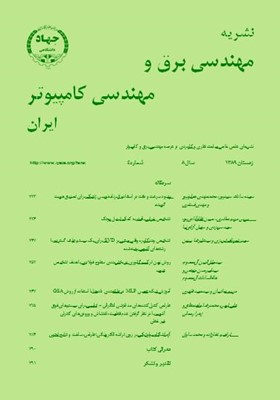آزمایشگاه بیولوژیکی بر روی تراشه الکترونیکی: طراحی، ساخت و نتایج تجربی
محورهای موضوعی : مهندسی برق و کامپیوترابراهیم غفارزاده 1 , محمد ساوان 2
1 - دانشگاه McGillکانادا
2 - دانشگاه پلیتکنیک مونترال کانادا
کلید واژه: آزمایشگاه بیولوژیکی بر روی تراشه الکترونیکی حسگر خازنی کانال میکروفلوئیدیکی و نمایش رشد باکتری,
چکیده مقاله :
این مقاله به معرفی یکی از کاربردهای جدید تراشههای الکترونیکی در عرصه علوم زیستی میپردازد. جایدادن یک آزمایشگاه بیولوژیکی بر روی یک تراشه کوچک، موضوعی است که در سالهای اخیر امیدهای بسیاری را جهت تشخیص بیماریها به کمک دستگاههای الکترونیکی قابل حمل بهوجود آورده است. ما نیز در این مقاله به شرح تکنیکهای ساخت سیستمی میپردازیم که ضمن فراهمآوردن محیطی در ابعاد کمتر از یکصدم میلیمتر مکعب جهت رشد باکتریها، قادر است برآوردی از رشد باکتری را نیز بهصورت تابعی از زمان ارائه نماید. این سیستم از دو بخش الکترونیکی و میکروفلوئیدیکی تشکیل شده است. بخش الکترونیکی این سیستم را یک حسگر خازنی تشکیل میدهد که تغییرات خازنی ناشی از رشد باکتری را به سیگنالی الکتریکی تبدیل میکند و بخش میکروفلوئیدیکی آن را یک کانال به قطری در حدود یکصد میکرومتر تشکیل میدهد که در بالای سطح تراشه حسگر ساخته میشود. این مقاله ضمن ارائه نتایج ساخت سیستم طراحیشده، منحنیهای رشد باکتری "E.Coli" با غلظتهای اولیه 10^6 و 10^7 در یک میلیلیتر از ماده نگهدارنده را به نمایش میگذارد.
In this paper, a complementary metal–oxide semiconductor (CMOS) based Laboratory-on-Chip platform is presented for bacteria growth monitoring. This platform integrates a 0.18 µm CMOS chip with two microfluidic channels. The proposed CMOS chip manufactured by Taiwan Semiconductor Manufacturing Company (TSMC) features a differential capacitive sensor along with two reference and sensing interdigitized electrodes. Two microfluidic channels are thereafter implemented atop the electrodes through a direct-write assembly technique. These microchannels are filled with pure Luria-Bertani (LB) medium and Escherichia Coli (E. Coli) bacteria suspended in the LB medium, respectively. We demonstrate and discuss the experimental results by using two different bacteria concentrations in the order of 10^6 and 10^7 per 1 mL in the LB medium.
[1] C. Stagni, et al., "CMOS DNA sensor array with integrated A/D conversion based on label-free capacitance measurement," IEEE J. of Solid-State Circuits, vol. 41, no. 12, pp. 2956-2964, Dec. 2006.
[2] H. Y. Kim, et al., "Real-time detection of microbial contamination," IEEE Engineering in Medicine and Biology Mag., vol. 23, no. 1, pp. 122-129, Jan./Feb. 2004.
[3] Glucose Sensor by iTest Inc. http://www.itestglucose.com, Virus Sensor by ST-Microelectronics. http://www.st.com and Gene Chip by Affymetrix Inc http://www.affymetrix.com.
[4] H. Eltoukhy, K. Salama, and A. E. Gamal, "A 0.18 mm, CMOS bioluminescence detection lab-on-chip," IEEE J. of Solid-State Circuits, vol. 41, no. 3, pp. 651-662, Mar. 2006.
[5] S. B. Prakash and P. Abshire, "Tracking cancer cell proliferation on a CMOS capacitance sensor chip," Biosensors and Bioelectronics, vol. 23, no. 10, pp. 1449-1457, 15 May 2008.
[6] A. Balasubramanian, B. Bhuva, R. Mernaugh, and F. R. Haselton, "Si-based sensor for virus detection," IEEE J. Sensors, vol. 5, no. 3, pp. 340-344, Jun. 2005.
[7] C. Guiducci, C. Stagni, G. Zuccheri, A. Bogliolo, L. Benini, B. Samorìb, and B. Riccòa, "DNA detection by integrable electronics," Biosensors and Bioelectronics, vol. 19, no. 8, pp. 781-787, Mar. 2004..
[8] E. Ghafar-Zadeh and M. Sawan, "A hybrid microfluidic CMOS capacitive sensor dedicated to Lab - on - Chip applications," IEEE Trans. on Biomedical Circuits and Systems, vol. 1, no. 4, pp. 270-277, Dec. 2007.
[9] E. Ghafar - Zadeh, M. Sawan, and D. Therriault, "Novel direct - write CMOS-based laboratory-on-chip: design, assembly and experimental results," J. of Sensors and Actuators A: Physical, vol. 134, no. 1, pp. 27-36, 28 Feb. 2007.
[10] E. Spiller, A. Schöll, R. Alexy, K. Kümmerer, and G. A. Urban, "A sensitive microsystem as biosensor for cell growth monitoring and antibiotic testing," Sensors and Actuators A: Physical, vol. 130-131, pp. 27-36, 28 Feb..
[11] D. Sylvester, J. C. Chen, and H. Chenming, "Investigation of interconnect capacitance characterization using charge - based capacitance measurement (CBCM) technique and three - dimensional simulation," IEEE J. of Solid-State Circuits, vol. 33, no. 3, pp. 449-453, Mar. 1998.
[12] L. Yang, Y. Li, C. L. Griffis, and M. G. Johnson, "Interdigitated microelectrode (IME) impedance sensor for the detection of viable Salmonella typhimurium," Biosensors and Bioelectronics, vol. 19, no. 10, pp. 1139-1147, 15 May 2004.


